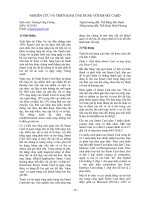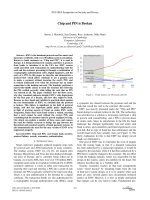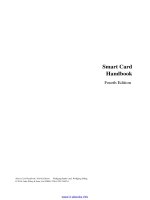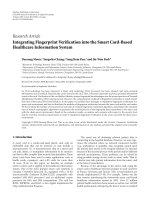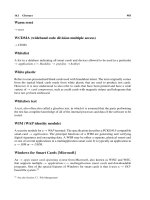OpenPGP smart card application
Bạn đang xem bản rút gọn của tài liệu. Xem và tải ngay bản đầy đủ của tài liệu tại đây (1.38 MB, 59 trang )
Functional Specification
of the
OpenPGP application
on
ISO Smart Card Operating Systems
Version 2.0.1
Author: Achim Pietig
© 2009
April 22
Author:
Achim Pietig
Lippstädter Weg 14
32756 Detmold
Germany
Email:
This document and translations of it may be copied and furnished to others, and derivative
works that comment on or otherwise explain it or assist in its implementation may be pre
pared, copied, published and distributed, in whole or in part, without restriction of any kind,
provided that the copyright notice and this paragraph are included on all such copies and
derivative works. However, this document itself may not be modified in any way, such as
by removing the copyright notice or references.
Many thanks to Werner Koch, Sten Lindgren and Rick van Rein for advice, error correction
and hints to this specification.
© 2009 Achim Pietig, Detmold
The author does not assume responsibility nor give a guarantee for the correctness
and/or completeness of the features and functions described in this document.
The author is unable to accept any legal responsibility or liability
for incorrect and/or incomplete details and their consequences.
Furthermore, the author reserves the right to revise these specifications for technical reasons
and make amendments and/or updates to the same.
History
V1.0 to V1.1:
•
Change of access rights for command GENERATE ASYMMETRIC KEY PAIR and
P1=81 (reading of public key) to always.
•
Adjustment of the literature.
•
New Data Objects for private use, with different access conditions. This optional fea
ture is announced in Extended capabilities.
•
New Data Objects for key generation date/time.
•
Data Object 'PW Status Bytes' (C4) mandatory for GET DATA as single object.
V1.1 to V2.0:
•
Correction of AID description (RID of FSFE).
•
Adjustment of the literature.
•
Alignment with changes and innovations in ISO 7816 and EN 14890.
•
Change in VERIFY command and password management.
•
Enhancement of Extended capabilities.
•
Enhancement of Algorithm attributes.
•
Reset functionality (life cycle management).
•
Definition of key import according to ISO 7816-8.
•
Additional Hash algorithms and different behaviour of PSO:CDS command.
•
Improvements for cards without MF.
•
New Data Objects:
•
Cardholder certificate (ISO 7816-6)
•
Extended header list for key import, supporting
•
Cardholder private key template (ISO 7816-6/-8)
•
Cardholder private key (ISO 7816-6/-8)
•
Historical bytes (ISO 7816-4/-6)
•
Algorithm attributes for PUT DATA
•
Resetting Code for PUT DATA
•
SM keys for PUT DATA
•
Deletion of DOs 'FF', 'E0'-'E2'.
•
Support for Secure Messaging.
•
Support for Command Chaining.
•
Support for different algorithm and key length (see PUT DATA for Algorithm attributes).
•
Introduction of a Resetting Code for RESET RETRY COUNTER.
•
Simplification in password management.
•
Several editorial clarifications.
TABLE OF CONTENTS
1 Introduction......................................................................................................................6
1.1 Definition of Abbreviations..........................................................................................7
2 General Requirements.....................................................................................................8
2.1 Limitations in This Version..........................................................................................9
3 Directory Structure........................................................................................................10
4 Directory and Data Objects of the OpenPGP Application.........................................11
4.1 Data Files and Objects in the MF or Other DFs.......................................................11
4.1.1 EF_DIR..............................................................................................................11
4.1.2 DF_OpenPGP...................................................................................................12
4.1.2.1 Application Identifier (AID)...................................................................................12
4.2 User Verification in the OpenPGP Application.........................................................14
4.2.1 Resetting Code.................................................................................................15
4.3 Data Objects (DO)....................................................................................................15
4.3.1 DOs for GET DATA...........................................................................................15
4.3.2 DOs for PUT DATA...........................................................................................18
4.3.3 DOs in Detail.....................................................................................................19
4.3.3.1 Private Use..........................................................................................................19
4.3.3.2 Name...................................................................................................................19
4.3.3.3 Language Preferences........................................................................................19
4.3.3.4 Sex......................................................................................................................20
4.3.3.5 Extended Capabilities..........................................................................................20
4.3.3.6 Algorithm Attributes.............................................................................................22
4.3.3.7 Private Key Template..........................................................................................23
4.3.4 Length Field of DOs..........................................................................................24
5 Security Architecture.....................................................................................................25
6 Historical Bytes..............................................................................................................27
6.1 Card Capabilities......................................................................................................28
7 Commands......................................................................................................................29
7.1 Usage of ISO Standard Commands.........................................................................29
7.2 Commands in Detail.................................................................................................30
7.2.1 SELECT FILE....................................................................................................31
7.2.2 VERIFY.............................................................................................................32
7.2.3 CHANGE REFERENCE DATA.........................................................................32
7.2.4 RESET RETRY COUNTER..............................................................................33
7.2.5 GET DATA........................................................................................................34
7.2.6 PUT DATA........................................................................................................35
7.2.7 GET RESPONSE..............................................................................................36
7.2.8 PSO: COMPUTE DIGITAL SIGNATURE.........................................................37
7.2.8.1 Hash Algorithms..................................................................................................38
7.2.8.2 DigestInfo for RSA...............................................................................................38
7.2.9 PSO: DECIPHER..............................................................................................40
7.2.10 INTERNAL AUTHENTICATE..........................................................................41
7.2.10.1 Client/Server Authentication..............................................................................42
7.2.11 GENERATE ASYMMETRIC KEY PAIR.........................................................43
7.2.12 GET CHALLENGE..........................................................................................45
7.2.13 TERMINATE DF..............................................................................................45
7.2.14 ACTIVATE FILE..............................................................................................46
7.3 Command Usage under Different I/O Protocols.......................................................47
7.4 Class Byte Definitions...............................................................................................47
7.5 Secure Messaging (SM)...........................................................................................47
7.6 Logical Channels......................................................................................................49
7.7 Command Chaining..................................................................................................49
7.8 Life Cycle Management............................................................................................50
7.9 Status Bytes..............................................................................................................51
8 Literature.........................................................................................................................52
9 Flow Charts.....................................................................................................................53
9.1 Application Selection................................................................................................54
9.2 Compute Digital Signature........................................................................................56
9.3 Decrypt Message......................................................................................................57
9.4 Generate Private Key...............................................................................................58
9.5 Client/Server Authentication.....................................................................................59
© 2009
OpenPGP application
Version 2.0.1
5
1 Introduction
This functional specification describes the OpenPGP application based on the functionality
of ISO smart card operating systems. In principle it defines the interface of the application
between card and terminal, in this context the OpenPGP software with a standard card
reader on PC/SC basis.
The solution takes care of:
•
use of international standards,
•
avoiding of patents,
•
free usage under GNU General Public License,
•
independence from specific smart card operating systems (second source),
•
easy enhancement for future functionality,
•
international use.
Consequently this specification does not deal with the description of the global commands
and data fields of the card, the security functions generally provided by the card, any fea
tures that apply to more than one application, such as transmission protocols, nor with the
description of the general mechanical and electrical characteristics of the card.
In particular, the specification provides a detailed description of the data objects directly
related to the applications and their respective content formats. Contents of the application
data are only prescribed if they represent a constant factor of the application.
Besides the definitions in this specification a card may support any other protocols, com
mands, data and variants. However, the OpenPGP application (e.g. GnuPG) should use
only the defined features in this specification to be compatible to different implementations.
The encoding values mentioned in the specification are stated in hexadecimal form, unless
otherwise indicated.
© 2009
OpenPGP application
Version 2.0.1
6
1.1 Definition of Abbreviations
AC
AID
ATR
AUT
BCD
CLA
CRT
DEC
dec.
DF
DIR
DO
DSI
ECDSA
EF
FCI
FCP
FID
INS
LCS
MF
OS
PK
PW
RC
RFU
RSA
SE
SIG
SK
SM
SSC
URL
UTF-8
© 2009
Access Condition
Application IDentifier
Answer To Reset
AUThentication
Binary Coded Decimal
CLAss byte
Control Reference Template
DECipher
Decimal
Dedicated File
DIRectory
Data Object
Digital Signature Input
Elliptic Curve Digital Signature Algorithm
Elementary Dile
File Control Information
File Control Parameter
File IDentifier
INStruction byte
Life Cycle Status
Master File
Operating System
Public Key
PassWord
Resetting Code
Reserved for Future Use
Rivest-Shamir-Adleman
Security Environment
SIGnature
Secret Key
Secure Messaging
Send Sequence Counter
Uniform Resource Locator
UCS Transformation Format 8 (compatible with 7-bit US-ASCII for all
characters < 80)
OpenPGP application
Version 2.0.1
7
2 General Requirements
The OpenPGP application is designed to run under several ISO-compatible card operating
systems. The application can be developed on various chips and from different manufac
turers. For all implementations, the following requirements should be fulfilled.
Card ->
The OpenPGP application does evaluate Historical bytes for ‘Card capabilities’. For
•
that reason the card shall provide a 'DO Historical bytes'.
As single transmission protocol any ISO protocol is allowed.
•
•
T=1 is preferred for cards with contacts (chaining support, extended length).
•
The card may support different transmission protocols.
•
High speed modes are requested (maximum as possible for the chip).
•
Extended length (Lc and Le) fields are recommended.
•
The card shall announce this feature in ‘Card capabilities’.
•
If Extended length is not supported, the card shall support command chaining
and/or GET RESPONSE for large command/response data.
Reader (informative) ->
A common driver (CCID, PC/SC or CT-API) shall be supported.
•
•
The driver should be available for several platforms (e.g. Win32, Linux, Macin
tosh)
•
T=1 and T=0 shall be supported for cards with contacts
ã
High-Speed protocols should be supported.
ã
Extended length shall be supported.
â 2009
OpenPGP application
Version 2.0.1
8
2.1 Limitations in This Version
This version of the OpenPGP application has some restrictions in the terminal application
and also in the card. The main reason is that actual cards and card readers do not support
all requirements.
Terminal application:
•
ECDSA and DSA are not supported (only RSA algorithm is used for all functions)
Card:
•
High-Speed protocol may not be supported (terminal assumes standard values of ISO
in that case)
•
RSA is the only defined algorithm (minimum 1024 bit). EN 14890 recommends ECDSA
as the preferred algorithm for signature cards in the future. RSA should be used as a
fall-back algorithm. In a couple of years most smart cards will be available for ECDSA
and it is highly recommended to add this algorithm to the OpenPGP specification (RFC
4880).
Card reader:
•
High-Speed protocol may not be supported (terminal assumes standard values of ISO
in that case).
© 2009
OpenPGP application
Version 2.0.1
9
3 Directory Structure
The following diagram gives an overview of the directory and data objects which are relev
ant to the OpenPGP application. Security related data (e.g. keys, passwords) are stored in
accordance to the used OS (files, data objects or other).
MF
Master File
3F 00
EF DIR
Directory
2F 00
DF OpenPGP
Directory
with AID
Local
Passwords
Application DOs
Private Keys
Sig, Dec, Aut
Signature
Counter
Fingerprints
Sig, Dec, Aut
Secure
messaging
keys
Application DOs
Declarations:
Mandatory
DF/EF
© 2009
Optional DF/EF
OpenPGP application
Mandatory DO
Version 2.0.1
Optional DO
10
4 Directory and Data Objects of the OpenPGP Application
The DF_OpenPGP directory and the data objects contained therein constitute the Open
PGP application. On the card several other applications may exist in specific Dedicated
Files (DF). Because the application supports cards without Master File (MF), no data out
side the OpenPGP application are addressed.
4.1 Data Files and Objects in the MF or Other DFs
The OpenPGP application uses its own set of data, including keys and passwords. No
files/data in the MF or other DFs are needed for the application. However the operating
system may store common data, like passwords, sharable in the card and use them for
several applications.
4.1.1 EF_DIR
This optional file under the MF (file identifier: ’2F00’) may contain one or several applica
tion templates and/or application identifiers as defined in ISO/IEC 7816-4. The data file is
not requested and evaluated by the OpenPGP application, but may be used to declare the
application to 3rd parties. The following entries should be added in that case:
•
Application Identifier (tag ‘4F’), only the significant values should be used (6 bytes =
D27600012401)
•
Application label (tag ‘50’), the application label should contain the following UTF-8
encoded text: OpenPGP
Example:
An entry in EF_DIR is an application template (Tag 61) in most cases. The template is
stored in a record or is appended to a previous template in case of a binary structure of the
EF_DIR. An entry has the content:
61 11 4F 06 D27600012401 50 07 'OpenPGP'
© 2009
OpenPGP application
Version 2.0.1
11
4.1.2 DF_OpenPGP
The directory of the OpenPGP application is stored anywhere in the card. It has no fixed
File Identifier (FID), so it is easy to integrate the application in any existing context. The
FID (if needed) can be chosen by the card manufacturer or any other party. In the directory
all data objects of the application are accessable. The OpenPGP application can be selec
ted with a SELECT FILE command directly after a Reset of a card. The SELECT FILE
command may return FCPs (File Control Parameter), but the OpenPGP application in the
terminal will not evaluate them.
4.1.2.1 Application Identifier (AID)
The OpenPGP application is selectable by a unique application identifier (see SELECT
FILE). The AID has a length of 16 bytes (dec.) and is coded in the following way. The AID
is unique for each card and it is recommended to integrate this value in certificates, e.g. for
client/server authentication. The RID in the AID is registered by FSF Europe e.V.
RID
PIX
Coding
D2 76 00 01 24
01
xx xx
xx xx
xx xx xx xx
Length (dec.)
5
1
2
2
4
Name
RID of FSFE Application Version Manufacturer Serial num
ber
RID
PIX
Application
Version
Manufacturer
Serial number
RFU
© 2009
00 00
2
RFU
Registered application provider identifier (unique identification of
FSFE), ISO 7816-5
Proprietary application identifier extension
(defined for OpenPGP application)
Indication of the application (OpenPGP)
Version number of the application
Unique code for the manufacturer of the application (card)
Unique serial number
Reserved for Future Use
OpenPGP application
Version 2.0.1
12
Application
This value (1 byte binary) specifies the application. With this definition it is possible to
design different applications under control of FSF Europe e.V. in the future. The following
values are defined:
00
1
2
...
FF
Reserved
OpenPGP application (standard)
SmartChess
Reserved
Version
The version number (2 bytes, BCD) gives information about the current status of the
application. With this value it is possible to announce updates to the outside world. The
version number is defined as follows:
Byte 1
Main version
Byte 2
Secondary version
(values from 00 – 99)
Example: A version
1.0
2.1
11.7
is coded
01 00
02 01
11 07
Manufacturer
To identify a card in open networks (e.g. key servers) and for the purpose of Log-In in local
or open networks or to a single computer, it is necessary to have unique application num
bers (related to a specific card). For that reason, every card manufacturer or personaliser who makes the card/application ready to run - has a unique address. This manufacturer
identification is controlled by FSF Europe e.V. and given to every interested manufacturer
for free. Only registered manufactures are allowed to produce applications compatible with
an OpenPGP application. The system works similar to MAC addresses on network cards.
The 2 bytes are coded binary and the values 0000 and FFFF are reserved for test pur
poses.
© 2009
OpenPGP application
Version 2.0.1
13
Serial Number
Each OpenPGP application on a card from a manufacturer/personaliser has a unique
serial number. The manufacturer/personaliser is responsible that no cards with duplicate
numbers will occur in the outside world (like MAC addresses in networks). The number is 4
byte long (binary) and has the format MSB .. .. LSB (Most Significant Bit ... Least Signific
ant Bit). It should start with 00 00 00 01 for the first card with an OpenPGP application of a
manufacturer and normally is incremented automatically by him. However gaps in the
range of numbers are allowed.
4.2 User Verification in the OpenPGP Application
The OpenPGP application uses two local passwords for user verification, called PW (PW1
with 6 characters minimum and PW3 with 8 characters minimum). PW1 is also called userpassword and PW3 admin-password. PW1 (user) is the password used for signing and
decryption operations, PW3 (admin) is the security officer's password. PW1 is needed for
everyday use of the card, while PW3 is used to manage the card.
The format of the PWs is UTF-8 (case sensitive), the maximum length supported by the
card for each PW is declared in the ´PW maximum length´ DO. Only the relevant bytes are
used in the PW commands, no fillers or paddings are added. The storage of the PWs is
dependent on the card OS, global PWs (used by other applications as well) may be used
but mapped to the application as local. PW1 is used as access condition for the command
PSO:CDS, PSO:DEC, INT-AUT, GET DATA and PUT DATA. The command PSO:CDS
uses PW1 in a different mode then the other commands. The OpenPGP application uses
PW3 as access condition for the commands RESET RETRY COUNTER, PUT DATA and
GENERATE ASYMMETRIC KEY PAIR. All PWs use an error counter with an initial value
of 3. This error counter is readable with GET DATA. After correctly verifying the PW, the
access status of the corresponding PW remains valid up to a RESET of the card, a
SELECT FILE to a different DF or an internal resetting by specific commands.
If the card is delivered without personalisation and/or PW letter, then a default content is
assumed: PW1 = “123456” (6 bytes, 313233343536); PW3 = “12345678” (8 bytes,
3132333435363738). It is highly recommended that the card holder changes these values.
© 2009
OpenPGP application
Version 2.0.1
14
4.2.1 Resetting Code
If, for example, the card is issued by an authority or company, the users will get a com
plete personalised card with keys and password. The user should be able to work with the
card, but is not permitted to change card data like keys and DOs under control of the
issuer. He must know his user-password (PW1), but is not aware of the admin-password
(PW3). To reset PW1 in the case of a blocked error counter, a special Resetting Code
(RC) is introduced. The issuer should give the RC to the user together with his password.
The Resetting Code has the same format as the password and is stored in a DO 'RC'. The
maximum length is announced in PW Status bytes, the minimum length is 8 bytes. The
Resetting Code can be used within the command RESET RETRY COUNTER instead of
the admin-password (PW3). It is only valid for resetting PW1. By default DO 'RC' is empty
and the related error counter is zero, so it cannot be used. The Resetting Code has an
error counter with an initial value of 3. This error counter is readable with GET DATA. The
DO 'RC' can be set to any value with a PUT DATA command after correct verification of
the admin-password (PW3), the error counter then is set to 3.
4.3 Data Objects (DO)
To keep the interface to terminals simple and for the reason to integrate the OpenPGP
application in different card OS, all relevant data elements for the application are stored as
data objects. Terminals can run the application only with the SELECT FILE, GET DATA,
PUT DATA and cryptographic commands. Changing of any file identifier, short file identi
fier, file type or file structure has no influence on the terminal interface. DOs are stored in a
TLV (Tag, Length, Value) format, whenever possible definitions of ISO (e.g. 7816-6) are
used.
4.3.1 DOs for GET DATA
The following DOs shall be supported by the GET DATA command. They can be accessed
at least in the OpenPGP DF of the card. Simple DOs (S) return only the value with GET
DATA. Constructed DOs (C, marked yellow) are returned including their tag and length. In
constructed DOs additional DOs may occur (not defined here) but are not evaluated by the
OpenPGP application in the terminal. The DOs in cursive letters cannot accessed directly
with GET DATA as single DO, the OpenPGP application in the terminal uses the non-curs
© 2009
OpenPGP application
Version 2.0.1
15
ive DOs (mostly constructed) only. Some of the DOs are optional (marked green), the
occurrence is announced in Extended capabilities. DOs may appear several times in the
table, if they are defined as single DO and occur in constructed DOs also. The order of
DOs in a constructed DO may vary.
Tag
0101
Format
S
0102
S
0103
S
0104
S
4F
5E
S
S
5F50
S
5F52
S
65
5B
5F2D
5F35
C
S
S
S
Cardholder Related Data (Tag)
Name (up to 39 bytes (dec.), according to ISO/IEC 7501-1)
Language preferences, max. 8 bytes (according to ISO 639)
Sex, 1 byte (according to ISO 5218)
6E
4F
5F52
C
S
S
73
C0
C
S
C1
S
C2
C3
S
S
Application Related Data (Tag)
Application identifier (AID), 16 (dec.) bytes (ISO 7816-4)
Historical bytes, up to 15 bytes (dec.), according to ISO 7816-4.
Card capabilities shall be included.
Discretionary data objects (Tag)
Extended capabilities
10 bytes (dec.), Flag list
Algorithm attributes signature
1 Byte Algorithm ID, according to RFC 4880
further bytes depending on algorithm (e.g. length modulus and
length exponent)
Algorithm attributes decryption
Algorithm attributes authentication
© 2009
Description
Optional DO for private use, max. 254 (dec.) bytes (binary, propriet
ary), can be used to store any information.
Optional DO for private use, max. 254 (dec.) bytes (binary, propriet
ary), can be used to store any information.
Optional DO for private use, max. 254 (dec.) bytes (binary, propriet
ary), can be used to store any information.
Optional DO for private use, max. 254 (dec.) bytes (binary, propriet
ary), can be used to store any information.
Application identifier (AID), 16 (dec.) bytes (ISO 7816-4)
Login data, max. 254 (dec.) bytes (binary, proprietary)
This DO can be used to store any information used for the Log-In
process in a client/server authentication (e.g. user name of a net
work).
Uniform resource locator (URL, as defined in RFC 1738), up to 254
(dec.) bytes. The URL should contain a Link to a set of public keys
in OpenPGP format, related to the card.
Historical bytes, up to 15 bytes (dec.), according to ISO 7816-4.
Card capabilities shall be included.
OpenPGP application
Version 2.0.1
16
Tag
C4
Format
S
C5
S
C6
S
CD
S
7A
93
C
S
Security support template (Tag)
Digital signature counter (counts usage of Compute Digital Signa
ture command), 3 bytes binary, ISO 7816-4
7F 21
C
Cardholder certificate
This DO is designed to store a certificate (e.g. X.509) for the AUTkey in the card. It can be used to identify the card in a client-server
authentication, where specific non-OpenPGP-certificates are
needed. The maximum length of this DO is announced in Extended
capabilities. The content should be TLV-constructed, but is out of
scope of this specification.
It may be necessary to use GET RESPONSE to read the content
with GET DATA.
C4
S
PW Status Bytes (7 bytes, binary)
1st byte: 00 = PW1 (no. 81) only valid for one PSO:CDS command
01 = PW1 valid for several PSO:CDS commands
nd
2 byte: max. length of PW1 (user)
3rd byte: max. length of Resetting Code (RC) for PW1
4th byte: max. length of PW3 (admin)
Byte 5, 6, 7 (first byte for PW1, second byte for Resetting Code,
third byte for PW3):
Error counter of PW1, RC and PW3. If 00, then the corres
ponding PW/RC is blocked. Incorrect usage decrements the
counter, correct verification sets to default value = 03.
© 2009
Description
PW Status Bytes (7 bytes, binary)
1st byte: 00 = PW1 (no. 81) only valid for one PSO:CDS command
01 = PW1 valid for several PSO:CDS commands
nd
2 byte: max. length of PW1 (user)
3rd byte: max. length of Resetting Code (RC) for PW1
4th byte: max. length of PW3 (admin)
Byte 5, 6, 7 (first byte for PW1, second byte for Resetting Code,
third byte for PW3):
Error counter of PW1, RC and PW3. If 00 then the corres
ponding PW/RC is blocked. Incorrect usage decrements the
counter, correct verification sets to default value = 03.
Fingerprints (60 bytes (dec.), binary, 20 bytes (dec.) each for Sig,
Dec, Aut in that order), zero bytes indicate a not defined private key
List of CA-Fingerprints (60 bytes (dec.), binary, 20 bytes (dec.)
each) of “Ultimately Trusted Keys”. Zero bytes indicate a free entry.
May be used to verify Public Keys from servers.
List of generation dates/times of public key pairs, 12 bytes (dec.)
binary. 4 bytes, Big Endian each for Sig, Dec and Aut. Each value
shall be seconds since Jan 1, 1970. Default value is 00000000 (not
specified).
OpenPGP application
Version 2.0.1
17
4.3.2 DOs for PUT DATA
The following DOs are supported by the PUT DATA command. They can be accessed at
least in the OpenPGP DF of the card.
Tag
0101
0102
0103
0104
4D
Format
S
S
S
S
C
5B
5E
5F2D
5F35
5F50
7F 21
S
S
S
S
S
C
C1
S
C2
S
C3
S
C4
S
C7
S
C8
C9
CA
CB
CC
CE
S
S
S
S
S
S
CF
D0
S
S
© 2009
Description
Optional DO for private use, max. 254 (dec.) bytes (binary)
Optional DO for private use, max. 254 (dec.) bytes (binary)
Optional DO for private use, max. 254 (dec.) bytes (binary)
Optional DO for private use, max. 254 (dec.) bytes (binary)
Extended Header list (used for key import), uses:
7F48 (Cardholder private key template)
5F48 (Cardholder private key)
Name
Login data
Language preferences
Sex
Uniform resource locator (URL)
Cardholder certificate
This DO is designed to store a certificate (e.g. X.509) for the AUTkey in the card. It can be used to identify the card in a client-server
authentication, where specific non-OpenPGP-certificates are
needed. The maximum length of this DO is announced in Extended
capabilities. The content should be TLV-constructed, but is out of
scope of this specification.
It may be necessary to use command chaining for writing the DO
with PUT DATA.
Optional DO (announced in Extended capabilities).
Algorithm attributes signature
Optional DO (announced in Extended capabilities).
Algorithm attributes decryption
Optional DO (announced in Extended capabilities).
Algorithm attributes authentication
Optional DO (announced in Extended capabilities).
1st PW Status Byte (1 byte binary):
00 = PW1 (No. 81) only valid for one PSO:CDS command
01 = PW1 valid for several PSO:CDS commands
Fingerprint (binary, 20 bytes dec.) for signature key, format accord
ing to RFC 4880
Fingerprint (binary, 20 bytes dec.) for decryption key
Fingerprint (binary, 20 bytes dec.) for authentication key
1st CA-Fingerprint in list (binary, 20 bytes dec.)
2nd CA-Fingerprint in list (binary, 20 bytes dec.)
3rd CA-Fingerprint in list (binary, 20 bytes dec.)
Generation date/time of signature key (4 bytes Big Endian, format
according to RFC 4880
Generation date/time of decryption key (4 bytes Big Endian)
Generation date/time of authentication key (4 bytes Big Endian)
OpenPGP application
Version 2.0.1
18
Tag
D1
Format
S
D2
S
D3
F4
S
C
Description
Optional DO (announced in Extended capabilities) for SM.
SM-Key-ENC for cryptogram (24 bytes dec. in case of Triple-DES,
16 bytes in case of AES)
Optional DO (announced in Extended capabilities) for SM.
SM-Key-MAC for cryptographic checksum (24 bytes dec. in case of
Triple-DES, 16 bytes in case of AES)
Resetting Code, 0 or 8 – xx bytes (dec.), binary
Optional DO (announced in Extended capabilities) for SM.
Container for both SM keys (ENC and MAC) with Tags D1 and D2.
Useful for updating or deleting both keys simultaneous.
4.3.3 DOs in Detail
The following chapter describes some DOs in detail, especially the proprietary DOs.
4.3.3.1 Private Use
These optional DOs can be used by the card holder, administrator or any application for
proprietary data (e.g. password list). The difference between the DOs are the access con
ditions. The presence of this DOs is announced in Extended capabilities.
4.3.3.2 Name
This interindustry data element consists of up to 39 bytes, each byte is a character from
ISO 8859-1 (Latin 1) alphabet (identical to 7-bit-US-ASCII for characters < 80). The data
element consists of surname (e.g. family name and given name(s)) and forename(s)
(including name suffix, e.g., Jr. and number). Each item is separated by a ´<´ filler charac
ter (3C), the family- and fore-name(s) are separated by two ´<<´ filler characters.
4.3.3.3 Language Preferences
This data element consists of 1 to 4 pairs of bytes (e.g. 2 bytes or 6 bytes) with coding
according to ISO 639-1, ASCII lower case (e.g. de = german; en = english; nl = dutch; fr =
french). At least one entry (2 bytes) should be present, the first entry has highest priority.
The information can be used by the terminal for the user interface (e.g. language of text).
© 2009
OpenPGP application
Version 2.0.1
19
4.3.3.4 Sex
This data element of 1 byte (binary) represents the ´Sex´ of a person according to ISO
5218. The following values are defined for the OpenPGP application:
Male
Female
Not announced
31
32
39
The terminal can use the information for the user interface.
4.3.3.5 Extended Capabilities
The Extended capabilities consists of 10 bytes (dec.) with the following meaning:
The first byte is a table that indicates additional features to the terminal. A set bit (1)
means that the function is available, a value equalling zero means that the function is not
available. Bits can be set simultaneous.
Coding of byte 1 of Extended capabilities:
b8
1
-
b7
1
b6
-
b5
-
b4
-
b3
-
b2
-
-
-
1
-
1
-
-
-
-
-
-
-
1
-
1
-
-
-
-
-
-
-
0
© 2009
OpenPGP application
b1 Meaning
- Secure Messaging supported
- Support for GET CHALLENGE
The maximum supported length of a chal
lenge can be found in special bytes of Exten
ded capabilities.
- Support for Key Import
- PW1 Status byte changeable (DO C4 avail
able for PUT DATA)
- Support for Private use DOs (0101-0104)
- Algorithm attributes changeable with PUT
DATA
0 RFU
Version 2.0.1
20
The other bytes are coded as follows:
Byte
02
Length
01
03 - 04
02
05 - 06
02
07 - 08
02
09 - 0A
02
© 2009
Value
Secure Messaging Algorithm
00 = Triple-DES (168 bit. dec.)
01 = AES (128 bit, dec.)
If SM is not supported (see 1st byte), the coding is 00
Maximum length of a challenge supported by the command GET
CHALLENGE (unsigned integer, Most Significant Bit ... Least
Significant Bit)
If GET CHALLENGE is not supported (see 1st byte), the coding
is 0000
Maximum length of Cardholder Certificate (DO 7F21). Coded as
unsigned integer (Most Significant Bit ... Least Significant Bit). If
the length is > FF and the card does not support Extended
length, then command chaining shall be used for PUT DATA.
The same is relevant if the card supports Extended length, but
the 'Maximum length of command data' is smaller than the
length of the DO.
Maximum length of command data
In future ISO specifications this information is available in an
EF_ATR under the MF. Because the definition is not finished yet
and OpenPGP supports cards without MF too, the information is
given here.
The unsigned integer value (Most Significant Bit ... Least Signi
ficant Bit) defines the maximum length of the command data
field (including SM) in any command, for Short or Extended
length (Lc/Le). If a card supports Extended length (see card cap
abilities), a maximum length of FF is assumed für Short length.
If command data exceeds the maximum length (e.g.
PSO:DECRYPT), then the command shall be send with com
mand chaining.
Maximum length of response data
The unsigned integer value (Most Significant Bit ... Least Signi
ficant Bit) defines the maximum length of the response field
(including SM) in any command, for Short or Extended length
(Lc/Le). If a card supports Extended length (see card capabilit
ies), a maximum length of 256 (dec.) is assumed for Short
length.
If a response exceeds the maximum length (e.g. GET DATA),
then the card should answer with status bytes 61xx and remain
ing data can be read with GET RESPONSE.
OpenPGP application
Version 2.0.1
21
4.3.3.6 Algorithm Attributes
This DO announces information related to the supported algorithm of the card. The ter
minal shall use this information for the key import functionality (if available). The formats
are used by the key generation in the card and are also related to the output format of the
corresponding command.
The content of the DO is optionally changeable (announced in Extended capabilities) with
PUT DATA. This is useful if the card supports several algorithms or different key length.
The attributes can be changed independent for each key, so it is possible for example to
use different key length for signing and decrypting. A card should reject unsupported val
ues in the DO. The supported values are manufacturer specific, please ask your card
vendor for the correct parameters if the card supports changing of the attributes.
If the attributes of an existing key are changed and do no longer match with the stored key,
the card should delete this key internally or prevent it from usage.
RSA:
Byte
01
Length
01
02 - 03
04 - 05
02
02
06
01
Value
Algorithm ID (RFC 4880)
01 = RSA (Encrypt or Sign)
Length of modulus n in bit (e.g. 1024 bit decimal = 0400), binary
Length of public exponent e in bit (e.g. 32 bit decimal = 0020),
binary
Format of private key
00 = standard (e, p, q)
01 = standard with modulus (n)
02 = crt (Chinese Remainder Theorem)
03 = crt with modulus (n)
This version defines only the content for the RSA algorithm. Future cards may support
ECDSA as recommended algorithm, but it is not supported by OpenPGP yet.
© 2009
OpenPGP application
Version 2.0.1
22
4.3.3.7 Private Key Template
If the card supports key import (see Extended Capabilities), the terms of the corresponding
private key are coded in the following way. The function does not matter how the key is
stored in the card internally. The function does not set the value of the corresponding fin
gerprint. The key import uses a PUT DATA command with odd INS (DB) and an Extended
header list (DO 4D) as described in ISO 7816-8.
The DOs in the Extended Header list start with a Control Reference Template (CRT) of the
referenced key.
Digital signature:
Confidentiality:
Authentication:
B6 00 (Tag, Length)
B8 00
A4 00
The next DO consists of a Cardholder private key template (7F48), that describes the
input and the length of the content of the following DO. The last DO (Cardholder private
key, 5F48) represents a concatenation of the key data elements according to the defini
tions in DO 7F48.
This version defines the input for PUT DATA for RSA keys only. The order of the DOs is
mandatory (the card may support any order), xx means a length field (1, 2 or 3 bytes).
Unnecessary DOs in between DO 7F48 should be stripped off (see format of private in
Algorithm attributes). Descriptions are in cursive letters, coded data are marked yellow.
4D xx Extended Header list
B6 or
B8 or
A4
00 Control Reference Template to indicate the private key
7F48
xx
5F48
© 2009
xx
Cardholder private key template
91
xx Public exponent: e
key format: standard and crt
92
xx Prime1: p
standard and crt
93
xx Prime2: q
standard and crt
94
xx PQ: 1/q mod p
crt
95
xx DP1: d mod (p - 1)
crt
96
xx DQ1: d mod (q - 1)
crt
97
xx Modulus: n
optional for standard and crt
Concatenation of key data as defined in DO 7F48
OpenPGP application
Version 2.0.1
23
Several chips for smart cards support only one coding for the Public exponent (e.g. 65537
dec.). The card may reject an imported key, if e does not match the internal requirements.
But the card shall accept 65537 dec. (10001) as value for e.
Some chips are not able to calculate n from p and q. In that case the modulus can be
integrated in the import. This feature is announced in 'Algorithm attributes'.
The length of the key data shall match the values given in the DO 'Algorithm attributes' (C1
– C3). E.g., if the Modulus n has a length of 1024 bit (dec.), then p and q have a fixed
length of 512 bits each.
In case of a signature key (CRT B6), the card internally resets the signature counter to
zero.
4.3.4 Length Field of DOs
According to ISO 7816-4 the length field in TLV-structures has the following format:
Number of bytes
1
2
First byte
00 – 7F
81
3
82
© 2009
OpenPGP application
Second byte
00 - FF
Version 2.0.1
Third byte
-
0000 - FFFF
Value (dec.)
0 – 127
0 – 255
0 - 65535
24
5 Security Architecture
All commands and data of a smart card are under control of the security of the card oper
ating system. ISO defines mechanisms, attributes (e.g. in FCP) and environments for
security purposes. Because this features are quite complex and may differ from card to
card (depending on mask developer), the OpenPGP application does not evaluate security
related items of a card. So this chapter is informative for the card developer and defines
the access conditions for all commands and data objects of the application in a common
way. The described security features are mandatory for the card, but the coding or the way
of implementation is up to the card developer, manufacturer or personaliser. Private keys
and passwords cannot be read from the card with any command or function. Commands
and data have access conditions to be fulfilled. The following tables show all access condi
tions for the OpenPGP application. READ is a synonym for all functions and commands of
the operations system that present data to the external world, WRITE is a synonym for all
functions and commands that change data in the Eeprom of the chip. If constructed DOs
are processed, the access conditions of each single DO shall be fulfilled.
Access conditions for relevant commands:
SELECT FILE
GET DATA
Command
Access condition
Always
Various
VERIFY
CHANGE REFERENCE DATA
Always
Always (version >= 2.0)
Description
Depending on
Data Objects
VERIFY of corresponding PW
(up to version 1.1)
RESET RETRY COUNTER
VERIFY of PW3 or
Resetting Code
Various
PUT DATA
GENERATE ASYMMETRIC KEY PAIR
PSO: COMPUTE DIGITAL SIGNATURE
PSO: DECIPHER
INTERNAL AUTHENTICATE
GET CHALLENGE
TERMINATE DF
Always (read pub-key)
VERIFY of PW3 (gener
ate key-pair)
VERIFY of PW1
VERIFY of PW1
VERIFY of PW1
Always
PW1 and PW3 is blocked
ACTIVATE FILE
Other commands
Always
Various
© 2009
OpenPGP application
Version 2.0.1
Depending on
Data Objects
With PW no. 81
With PW no. 82
With PW no. 82
Not allowed in
case of SM
e.g. commands
for personalisa
tion
25
